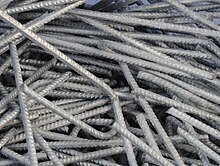Reinforcing wire
Reinforcement wire is a cold-formed , smooth (B500A + G) or profiled (B500A + P) reinforcing steel with a diameter of 4 to 12 mm, which is manufactured in rings and processed from the ring to reinforcement in the factory.
Profiled reinforcement wire is provided with profiled ribs on three sides of the ribs after cold forming by rolling to achieve bondability. Since the profile is much flatter than that of reinforcing steel, the shear bond in the concrete is lower. Reinforcement wire must therefore not be used for normal reinforcement purposes according to DIN 1045 in in- situ concrete construction or in precast concrete parts.
Use is only intended for special applications (e.g. reinforced concrete pipes according to DIN EN 639 or prefabricated parts made of aerated concrete according to DIN 4223).
Reinforcing wire can be obtained from the manufacturer in coils or cut to length in bars. In contrast to the other reinforcing steels standardized in DIN 488, the plant number within a country is not used to identify the origin. In the absence of profiling or ribbing, the smooth reinforcement wire must be provided with a weather-resistant label on which the manufacturer can be read.
Profiled reinforcement wire is identified as a profile by rolling on the factory mark. Here, by specifying tens and units, the work number is given, which is published in the list of the German Institute for Building Technology (DIBt) .
The reinforcement wire is standardized in DIN 488-3: 2009-08.
The short name for profiled reinforcement wire is B500A + P (formerly BSt 500 P / PK). The short name for smooth reinforcing wire is B500A + G (formerly BSt 500 G / GK).
The following mechanical parameters are prescribed by DIN 488:
- Yield strength Re 500 N / mm²
- Tensile strength Rm 550 N / mm²
- Yield strength ratio Rm / Re 1.05
- Total elongation at maximum load Agt 2.5%
